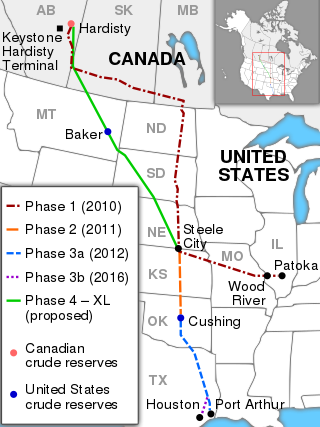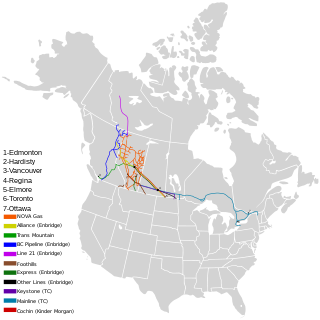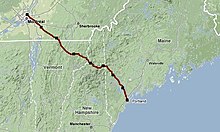
The Athabasca oil sands, also known as the Athabasca tar sands, are large deposits of oil sands rich in bitumen, a heavy and viscous form of petroleum, in northeastern Alberta, Canada. These reserves are one of the largest sources of unconventional oil in the world, making Canada a significant player in the global energy market.
Enbridge Inc. is a multinational pipeline and energy company headquartered in Calgary, Alberta, Canada. Enbridge owns and operates pipelines throughout Canada and the United States, transporting crude oil, natural gas, and natural gas liquids, and also generates renewable energy. Enbridge's pipeline system is the longest in North America and the largest oil export pipeline network in the world. Its crude oil system consists of 28,661 kilometres of pipelines. Its 38,300 kilometre natural gas pipeline system connects multiple Canadian provinces, several US states, and the Gulf of Mexico. The company was formed by Imperial Oil in 1949 as the Interprovincial Pipe Line Company Limited to transport Alberta oil to refineries. Over time, it has grown through acquisition of other existing pipeline companies and the expansion of their projects.

TC Energy Corporation is a major North American energy company, based in the TC Energy Tower building in Calgary, Alberta, Canada, that develops and operates energy infrastructure in Canada, the United States, and Mexico. The company operates three core businesses: Natural Gas Pipelines, Liquids Pipelines and Energy.

The Canadian Association of Petroleum Producers (CAPP), with its head office in Calgary, Alberta, is a lobby group that represents the upstream Canadian oil and natural gas industry. CAPP's members produce "90% of Canada's natural gas and crude oil" and "are an important part of a national industry with revenues of about $100 billion-a-year ."

Petroleum production in Canada is a major industry which is important to the overall economy of North America. Canada has the third largest oil reserves in the world and is the world's fourth largest oil producer and fourth largest oil exporter. In 2019 it produced an average of 750,000 cubic metres per day (4.7 Mbbl/d) of crude oil and equivalent. Of that amount, 64% was upgraded from unconventional oil sands, and the remainder light crude oil, heavy crude oil and natural-gas condensate. Most of the Canadian petroleum production is exported, approximately 600,000 cubic metres per day (3.8 Mbbl/d) in 2019, with 98% of the exports going to the United States. Canada is by far the largest single source of oil imports to the United States, providing 43% of US crude oil imports in 2015.
Dilbit is a bitumen diluted with one or more lighter petroleum products, typically natural-gas condensates such as naphtha. Diluting bitumen makes it much easier to transport, for example in pipelines. Per the Alberta Oil Sands Bitumen Valuation Methodology, "Dilbit Blends" means "Blends made from heavy crudes and/or bitumens and a diluent, usually natural-gas condensate, for the purpose of meeting pipeline viscosity and density specifications, where the density of the diluent included in the blend is less than 800 kg/m3." If the diluent density is greater than or equal to 800 kg/m3, the diluent is typically synthetic crude and accordingly the blend is called synbit.

The Keystone Pipeline System is an oil pipeline system in Canada and the United States, commissioned in 2010 and owned by TC Energy and, as of March 2020, the Government of Alberta. It runs from the Western Canadian Sedimentary Basin in Alberta to refineries in Illinois and Texas, and also to oil tank farms and an oil pipeline distribution center in Cushing, Oklahoma.

Although there are numerous oil companies operating in Canada, as of 2009, the majority of production, refining and marketing was done by fewer than 20 of them. According to the 2013 edition of Forbes Global 2000, canoils.com and any other list that emphasizes market capitalization and revenue when sizing up companies, as of March 31, 2014 these are the largest Canada-based oil and gas companies.
The Enbridge Northern Gateway Pipelines were a planned-but-never-built project for a twin pipeline from Bruderheim, Alberta, to Kitimat, British Columbia. The project was active from the mid-2000s to 2016. The eastbound pipeline would have imported natural gas condensate, and the westbound pipeline would have exported diluted bitumen from the Athabasca oil sands to a marine terminal in Kitimat for transportation to Asian markets via oil tankers. The project would have also included terminal facilities with "integrated marine infrastructure at tidewater to accommodate loading and unloading of oil and condensate tankers, and marine transportation of oil and condensate." The CA$7.9 billion project was first proposed in the mid-2000s but was postponed several times. The project plan was developed by Enbridge Inc., a Canadian crude oil and liquids pipeline and storage company.

The National Energy Board was an independent economic regulatory agency created in 1959 by the Government of Canada to oversee "international and inter-provincial aspects of the oil, gas and electric utility industries." Its head office was located in Calgary, Alberta.
Russell Keith Girling is a Canadian businessman. He served as the president and chief executive officer of TC Energy.
Western Canadian Select (WCS) is a heavy sour blend of crude oil that is one of North America's largest heavy crude oil streams and, historically, its cheapest. It was established in December 2004 as a new heavy oil stream by EnCana, Canadian Natural Resources, Petro-Canada and Talisman Energy. It is composed mostly of bitumen blended with sweet synthetic and condensate diluents and 21 existing streams of both conventional and unconventional Alberta heavy crude oils at the large Husky Midstream General Partnership terminal in Hardisty, Alberta. Western Canadian Select—the benchmark for heavy, acidic crudes—is one of many petroleum products from the Western Canadian Sedimentary Basin oil sands. Calgary-based Husky Energy, now a subsidiary of Cenovus, had joined the initial four founders in 2015.
Tidewater is a term used by industries and governments to refer to access to ocean ports with international marine services for import and export of commodities. For export, the commodities can be shipped via trucks, trains and/or pipelines to a port, thereby opening the door to more lucrative prices on global markets. Getting to such a port is particularly important for landlocked jurisdictions seeking to expand and diversify markets for natural resources.
Sonya M. Savage is a Canadian politician who was the minister of energy for Alberta from April 20, 2019, to October 2022. She was Minister of Environment and Protected Areas, being appointed on October 21, 2022. A member of the United Conservative Party (UCP), she was elected following the 2019 Alberta general election to represent Calgary-North West in the Legislative Assembly of Alberta. Savage also acted as the minister of justice and solicitor general of Alberta from January 18 to February 25, 2022, while incumbent minister Kaycee Madu underwent a probe into his conduct.
The Canadian province of Alberta faces a number of environmental issues related to natural resource extraction—including oil and gas industry with its oil sands—endangered species, melting glaciers in banff, floods and droughts, wildfires, and global climate change. While the oil and gas industries generates substantial economic wealth, the Athabasca oil sands, which are situated almost entirely in Alberta, are the "fourth most carbon intensive on the planet behind Algeria, Venezuela and Cameroon" according to an August 8, 2018 article in the American Association for the Advancement of Science's journal Science. This article details some of the environmental issues including past ecological disasters in Alberta and describes some of the efforts at the municipal, provincial and federal level to mitigate the risks and impacts.

This is a brief timeline covering the history of the petroleum industry Alberta and its predecessor states.
The Alberta Carbon Trunk Line (ACTL) is a CO2 pipeline owned and operated Wolf Midstream, which is 240 kilometres (150 mi) in length and part of a $CDN1.2 billion system that captures carbon dioxide from industrial emitters in the Alberta's Industrial Heartland and transports it to "central and southern Alberta for secure storage" in "aging reservoirs", and enhanced oil recovery (EOR) projects. The pipeline, upstream carbon capture infrastructure and downstream EOR project, which is owned and operated by Enhance Energy, came online on June 2, 2020 and are part of the ACTL System, which is the largest carbon capture and storage (CCS) system" in Alberta, Canada.
Modern Miracle Network (MMN) is a Canadian fossil fuel advocacy organization that was incorporated in 2016 by entrepreneur Michael Binnion, and operates out of the offices of Calgary, Alberta-based Questerre Energy. Binnion is chair of the Manning Foundation and a member of the board of governors of the Canadian Association of Petroleum Producers (CAPP).
The city of Cushing in Oklahoma is a central hub within the United States and worldwide oil industry. It connects major pipelines within the United States and is the location where the oil futures contracts end up being delivered. It is the physical delivery point of West Texas Intermediate oil.












